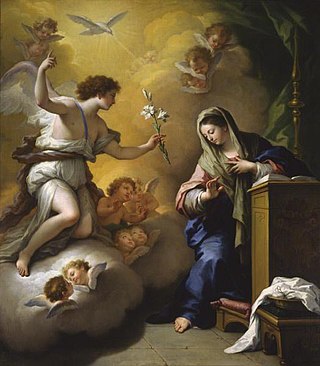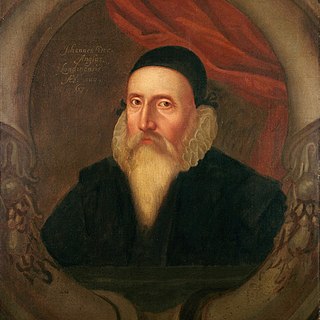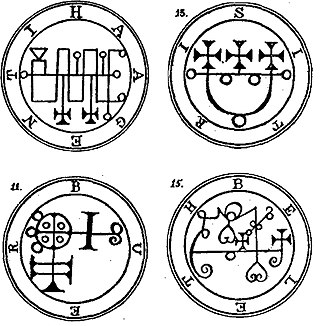Liber Juratus
Probably the oldest known description and image of the Sigillum Dei is the 14th-century Liber Juratus (also Liber Sacratus, Liber sacer sive Juratus, or Sworn Booke), [1] attributed to Honorius, son of Euclid. [2] This may have been produced in the late 13th century, but likely not before the time of Pope John XXII. (1316–1334). [3]
The description of the seal in the Liber Juratus begins with the dimensions of the circle surrounding the outside in relation to common symbol figures of the Christian tradition.
make first a circle whose diameter is three fingers, because of the three cross-nails of the Lord, or five fingers because of the five wounds of Christ, or seven for the seven sacraments, or nine for the nine orders of angels, but usually five fingers will suffice. Then make a second within this circle, let it be a distance from the first two grains because of the two Tablets of the Law of Moses, or three grains because of the persons of the Trinity. [4]
The so created circular band will be at an apex of a small cross and from this starting point proceed from left to right 72 Latin letters, which vary in tradition (MS Sloane 3853: h, t, o, e, x, o, r, a, b, a, s, l, a, y, q, c, i, y, s, t, a, l, g, a, a, o, n, o, s, v, l, a, r, y, c, e, k, s, p, f, y, o, m, e, n, e, a, u, a, r, e, l, a, t, e, d, a, t, o, n, o, n, a, o, y, l, e, p, o, t, m, a), the sum forming the Shemhamphorasch, in Jewish tradition the ineffable name of God ("magnum nomen Domini Semenphoras licterarum 72"), connected with the 36 decans of astrology. [5]
Next to the circular band is a pentagram, which focuses on a Greek Tau, this is surrounded by the five letters of the name of God "El" and "Ely", and five other pairs of letters (lx, al, a, c, to).
Inside the pentagon, in turn, is a heptagon drawn in such a way that its top side touches the centre tip of the pentagram, and the pages of this heptagon should be labelled with the names of seven angels and archangels Zadkiel, Samael, Zfadkiel, Raphael, Anael, Michael, Gabriel).
From this first heptagon is a second and a third drawing, whose description is hard to understand and has been interpreted differently in the manuscript illustrations, but has usually seven key points with crosses and labelled with two rows of Gods: a first series of seven names of God, each in three syllables or components disassembled and relating spatially with those on the initial and final syllables of the last names of angels and vertices of the figure, namely la-ya- ly (to Zfadkiel), na-ra-th (to Zadkiel), ly-bar-re (to Raphael), ly-ba-res (to Michael), (e) t-ly-alg (to Samael), ve -h-am (to Anael), and y-al-gal (to Gabriel); also in sub-segments seven more: Vos, Duynas, Gyram, Gram, Aysaram, Alpha and Omega, a third series El, On, El, On, El, On, Omega; as additions to the registered crosses the four letters a, g, a, l; and finally another group of five names of God Ely, Eloy, Christ, and Sother Adonay.
The colour of the seal of the Liber Juratus indicates that the pentagram is usually red, purple with yellow faces, the first heptagon blue, second yellow, the third yellow and the black circles, and also the area between the circles and all other surfaces were to turn green. In magical operations, this would be handled differently – instead drawn on virgin parchment with the blood of the mole, pigeon, hoopoe, bat or other animals, such as cattle, horses or deer.








